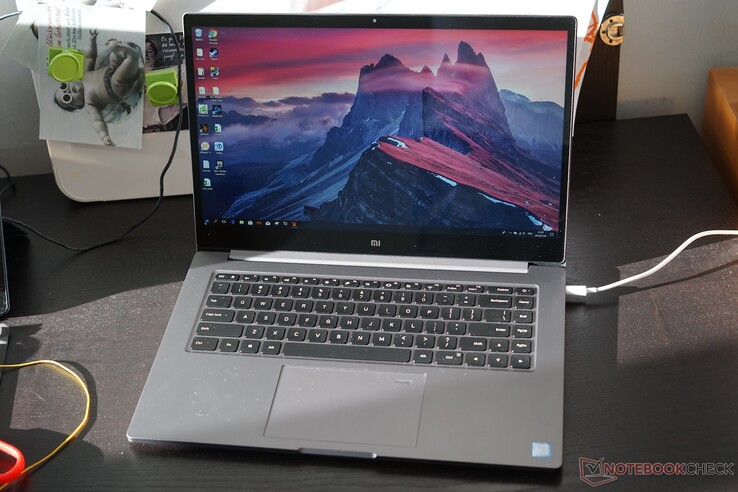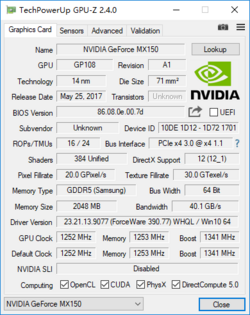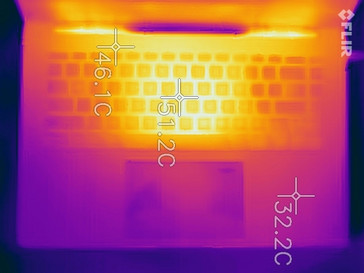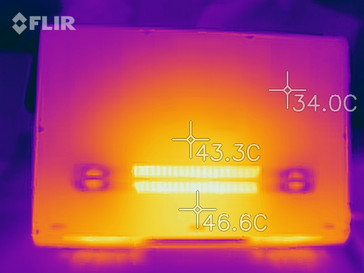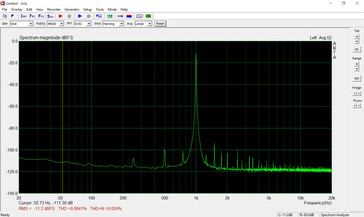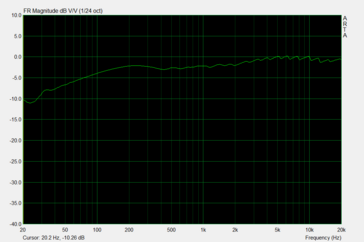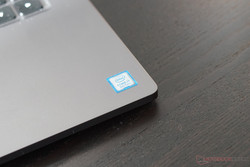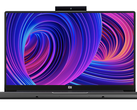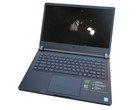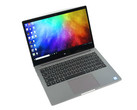Xiaomi Mi Notebook Pro (i7-8550U) Laptop Review

We have already reviewed the Xiaomi Mi Notebook Pro i5-8250U (November 2017) and were quite pleased with it. The design and quality of the aluminum case can be directly compared to the cases of Apple's MacBook Pro 15, the Asus ZenBook UX550 or the Dell XPS series, although the surface seems to be more prone to signs of wear. We had to criticize the missing Thunderbolt port, the slow SD card reader and the M.2 slots that are connected with only two lanes. On the other hand, we were happy to note the good battery runtimes, mainly silent operation under normal load, the bright, high-contrast display and the well-dimensioned Harman Infinity speaker that cannot quite keep up with the sound quality of the MacBook, but it can still produce a nice, high-quality sound.
We were also convinced by the device's price: While the online price for the Xiaomi Mi Notebook Pro i5-8250U (8 GB RAM + 256 GB SSD) currently lies at around $930, the Xiaomi Mi Notebook Pro i7-8550U with 8 GB of RAM costs a bit more at around $1000. If you are interested in the i7 model with 16 GB of RAM, you will have to hand over $1150. In addition to this, you will need to consider delivery, import tax and currency fluctuations.
But first let us take a look at the test results of the Xiaomi Mi Notebook Pro i7 with the stronger Intel Core i7-8550U. As all other features such as case, connectivity and display are identical, we will focus on the expected improved performance in this review.
Case & Connectivity
As the Xiaomi Mi Notebook Pro i7-8550U has the same build as the i5 model, we can only repeat our praise from November. The case is not constructed as a unibody case but as a pressed metal case with a reinforced magnesium frame on the inside. The feel of the aluminum case is good, and it gives the impression of high quality. Unfortunately, the only available color is a slightly boring gray. One thing we already noticed on the i5 version is that the surface shows scratches and other signs of use quite quickly. Comparable models such as the MacBook or the Dell XPS seem to be more resistant in this regard.
Display
The 15.6-inch display (NV156FHM-N61) has an FHD resolution of 1920x1080 pixels and is identical to that of the Xiaomi Mi Notebook Pro i5. The results of our tests are very similar. You can read up on the results in more detail (color accuracy, PWM results etc.) in our original review of the Xiaomi Mi Notebook Pro i5.
| Xiaomi Mi Notebook Pro i7 BOEhydis NV156FHM-N61, , 1920x1080, 15.6" | Xiaomi Mi Notebook Pro i5 BOE0747 NV156FHM-N61, , 1920x1080, 15.6" | Asus ZenBook 13 UX331UN B133HAN04.9, , 1920x1080, 13.3" | HP Spectre x360 15t-bl100 BOE06C3, , 3840x2160, 15.6" | Dell XPS 13 i7-8550U ID: Sharp SHP144A, Name: LQ133Z1, , 3200x1800, 13.3" | Acer Spin 5 SP515-51GN-80A3 AUO, B156HAN06.1, , 1920x1080, 15.6" | Lenovo IdeaPad 320S-13IKB InfoVision M133NWF4R0, , 1920x1080, 13.3" | Average of class Multimedia | |
|---|---|---|---|---|---|---|---|---|
| Display | ||||||||
| Display P3 Coverage (%) | 66.5 | 65.4 | 66.6 | 63.6 | 38.73 | 66.3 | 82 ? | |
| sRGB Coverage (%) | 86.9 | 93.1 | 86.9 | 93 | 58.3 | 97.4 | 91.8 ? | |
| AdobeRGB 1998 Coverage (%) | 63.5 | 66.4 | 63.5 | 65.4 | 40.02 | 68.1 | 77.3 ? | |
| Response Times | ||||||||
| Response Time Grey 50% / Grey 80% * (ms) | 47.9 ? | 22.4 ? | 41.2 ? | 35.6 ? | 42 ? | 56.8 ? | 18 ? | |
| Response Time Black / White * (ms) | 33.7 ? | 31.2 ? | 29.6 ? | 27.2 ? | 29 ? | 31.6 ? | 13.4 ? | |
| PWM Frequency (Hz) | 21800 ? | 1000 | 19690 ? | 198.4 ? | 992 ? | |||
| Screen | 6% | 8% | 2% | 5% | 31% | 38% | 34% | |
| Brightness middle (cd/m²) | 317 | 296 -7% | 338 7% | 338.7 7% | 386.1 22% | 221 -30% | 330 4% | 424 ? 34% |
| Black Level * (cd/m²) | 0.352 | 0.32 9% | 0.35 1% | 0.28 20% | 0.33 6% | 0.12 66% | 0.25 29% | 0.1761 ? 50% |
| Contrast (:1) | 901 | 925 3% | 966 7% | 1210 34% | 1170 30% | 1842 104% | 1320 47% | |
| Colorchecker dE 2000 * | 4.5 | 4.3 4% | 4.2 7% | 4.9 -9% | 4.2 7% | 4.12 8% | 1.8 60% | 2.74 ? 39% |
| Colorchecker dE 2000 max. * | 9 | 8.7 3% | 6.5 28% | 8.7 3% | 7.6 16% | 6.41 29% | 4.3 52% | 7.15 ? 21% |
| Greyscale dE 2000 * | 3.8 | 3 21% | 3.9 -3% | 5.5 -45% | 5.7 -50% | 3.4 11% | 2.5 34% | 2.87 ? 24% |
| Gamma | 2.17 101% | 2.1 105% | 2.43 91% | 2.08 106% | 2.28 96% | 2.54 87% | 2.11 104% | 2.22 99% ? |
| Brightness (cd/m²) | 288 | 321 | 325 | 357 | 224 | 304 | ||
| Brightness Distribution (%) | 89 | 90 | 91 | 83 | 89 | 88 | ||
| CCT | 7100 92% | 7144 91% | 7498 87% | 7336 89% | 6893 94% | 6588 99% | 6673 97% ? | |
| Color Space (Percent of AdobeRGB 1998) (%) | 56.83 | 60.4 | 63.5 | 59 | 37 | 61.8 | ||
| Color Space (Percent of sRGB) (%) | 86.86 | 93.1 | 86.92 | 92.2 | 58 | 97.3 | ||
| Total Average (Program / Settings) | 6% /
6% | 8% /
8% | 2% /
2% | 5% /
5% | 31% /
31% | 38% /
38% | 34% /
34% |
* ... smaller is better
Performance
Xiaomi's Mi Notebook Pro laptops are available in two CPU configurations: With the Intel Core i5-8250U or the stronger Intel Core i7-8550U. The i7 model is available with either 8 or 16 GB of RAM. Apart from the integrated graphics chip UHD 620, the Xiaomi Mi Notebook Pro also comes with an additional dedicated graphics card: The Nvidia GeForce MX150 with 2 GB of GDDR5 VRAM. Unfortunately, Xiaomi still only offers a 256-GB SSD in the i7 model. Luckily, users can insert an additional SSD for more storage thanks to the additional free M.2 slot.
Processor
So what are the differences between these two processors and how is the Intel Core i7-8550U faster or better? A look at the specification sheets of the quad-core chips shows that the Intel Core i5-8250U clocks between 1.6 and 3.4 GHz, while the base clock rate of the i7-8550U is a little higher at 1.8 GHz. The TDP of the Xiaomi Mi Notebook Pro i7 is set to 15 watts by default. In turbo mode, the clock rate increases to 4 GHz and, for 28 seconds, performance is boosted to 44 watts. The slim case of the Xiaomi Mi Notebook Pro means that a good cooling system is vital if you want this performance to be consistent.
A look at the Cinebench R15 Single test shows that the device performs splendidly in single-core use, as one might expect from the i7-8550U due to its high clock rate of 4 GHz. Compared to other Intel Core i7-8550U CPUs, the Xiaomi's performance is right at the front, together with that of the Acer Spin 5. Both have results that are significantly higher than the average result of all i7-8550U devices tested by Notebookcheck. However, all laptops (except for the HP Spectre x360) lie within the narrow margin of between 162 and 170 points.
Out of pure curiosity, we also included the HP Envy with the previous CPU version, the Intel Core i7-7500U, in our comparison table. This can even keep up with the Xiaomi Mi Notebook Pro i5 in the single-core tests, but the four cores of Intel's new eighth-generation chip play on their assets in the multi-core benchmark and easily outpace the i7-7500U. Compared to the average results of all i7-8550U and all multimedia notebooks, the Xiaomi does very well.
But the i7 from Xiaomi has the same difficulties as the i5 model: It quickly runs out of steam in a single run of the multi-core test. While the Dell XPS 13 and the Asus ZenBook 13 both showed average performance in the Cinebench R15 Single test, they lie ahead of the Xiaomi Mi Notebook Pro and the Acer Spin 5 in the multi-core benchmark. A look at the average results for this category confirms this impression: The Xiaomi Mi Notebook Pro is only minimally faster.
But not all that glitters is gold. Let us take a look at the Cinebench loop further on.
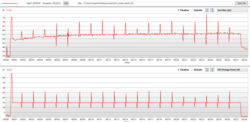
How does the Xiaomi i7 deal with throttling when it is under multi-core load for a prolonged period of time? The performance of the Xiaomi Mi Notebook Pro i7 drops from 560 to 520 points in the second round, which makes a loss of 7%. This is no big deal, however, and a look at the test results of the Asus ZenBook show that the Cinebench loop results can be a lot worse. The Asus, which is at the top of our table for the first round in which it scores 623 points, drops to an average of 456 points afterwards and even falls below 400 points at times.
As you can see from the temperature graph above on the right, the Xiaomi can handle its temperatures and cooling quite well even for a long period of time, and it remained nicely stable between 520 and 530 points. In the bottom half of the graph you can see the 28-second TDP rise to the maximum 44 watts, then the steady 15 watts which is interrupted by short peaks in performance. The top half shows how the CPU reaches a maximum of 57 °C (~134.6 °F) in the 30 minutes of the Cinebench loop.
We noticed that the Cinebench Multi results of the Xiaomi Mi Notebook Pro i5-8250U are actually slightly higher than those of the i7-8550U.
Surprising - our tested Core i5 model is faster than the i7 model under multi-core load.
The fact that the i5-8250U achieves a better result than the more powerful i7-8550U is due to the different clocking behavior of the CPUs. Both CPUs throttle after a short turbo mode of 28 seconds, but the i5-8250U continues with a slightly higher clock rate than the i7-8550U, which is why its results are a little lower in the synthetic benchmark test. It seems as if we have got a noticeably better chip with the i5 than with the i7.
System Performance
Like the Xiaomi Mi Pro i5, the i7 offers a satisfying system performance for everyday working, image-processing, video-processing and even a little gaming due to the dedicated GPU. Compared to other i7-8550U models, the Xiaomi lies just behind the Acer Spin 5 and the Asus ZenBook in the Work Score Accelerated v2. It is noticeably faster than the Dell XPS 13, HP Spectre x360, Razer Blade Stealth and the general Notebookcheck average.
| PCMark 8 Home Score Accelerated v2 | 3702 points | |
| PCMark 8 Creative Score Accelerated v2 | 5550 points | |
| PCMark 8 Work Score Accelerated v2 | 4978 points | |
Help | ||
Storage Device
The Xiaomi Mi Notebook Pro i7 is equipped with the same Samsung PM961 SSD as the i5 model and fortunately uses all four lanes of the PCIe connection.
| Xiaomi Mi Notebook Pro i7 Samsung PM961 MZVLW256HEHP | Xiaomi Mi Notebook Pro i5 Samsung PM961 MZVLW256HEHP | HP Spectre x360 15t-bl100 Samsung PM961 NVMe MZVLW512HMJP | Lenovo Yoga 920-13IKB-80Y7 Samsung PM961 MZVLW256HEHP | Asus ZenBook 13 UX331UN SanDisk SD8SN8U512G1002 | Acer Spin 5 SP515-51GN-80A3 Intel SSD 600p SSDPEKKW256G7 | Average Samsung PM961 MZVLW256HEHP | Average of class Multimedia | |
|---|---|---|---|---|---|---|---|---|
| CrystalDiskMark 3.0 | -0% | 9% | 9% | -59% | -27% | -8% | ||
| Read Seq (MB/s) | 1444 | 1260 -13% | 1248 -14% | 2070 43% | 430.6 -70% | 1187 -18% | 1627 ? 13% | |
| Write Seq (MB/s) | 1173 | 1241 6% | 1476 26% | 1125 -4% | 424.1 -64% | 599 -49% | 1136 ? -3% | |
| Read 512 (MB/s) | 816 | 1039 27% | 849 4% | 1252 53% | 275 -66% | 935 15% | 887 ? 9% | |
| Write 512 (MB/s) | 851 | 827 -3% | 1118 31% | 832 -2% | 369.8 -57% | 609 -28% | 781 ? -8% | |
| Read 4k (MB/s) | 61.5 | 60 -2% | 58.8 -4% | 56.2 -9% | 28.04 -54% | 35.61 -42% | 53 ? -14% | |
| Write 4k (MB/s) | 171.9 | 154 -10% | 155.2 -10% | 142.4 -17% | 53.5 -69% | 134.4 -22% | 126.7 ? -26% | |
| Read 4k QD32 (MB/s) | 568 | 526 -7% | 645 14% | 432.9 -24% | 322.9 -43% | 289.3 -49% | 419 ? -26% | |
| Write 4k QD32 (MB/s) | 436.4 | 435 0% | 547 25% | 573 31% | 211.9 -51% | 331.1 -24% | 384 ? -12% |
Graphics
The integrated graphics chip Intel UHD Graphics 620 is supported by the same dedicated graphics card, the Nvidia GeForce MX150 with 2 GB of GDDR5 VRAM, in both the i5 and the i7 devices. The MX150, successor of the GeForce 930M and GeForce 940M, and the mobile version of the Desktop GeForce GT 100, performs about 2.5 times better than the Intel UHD Graphics 620 in our 3DMark 11 benchmark. The GPU performance lies at the top of our comparison table and is similar to the performance in the i5 version and the Notebookcheck average. When compared to the stronger GTX 1050, the MX150 does not stand a chance. The MX150 is the limit of possible graphics performance for the Xiaomi, since you cannot connect external graphics docks due to the missing Thunderbolt port.
| 3DMark 11 Performance | 4572 points | |
| 3DMark Cloud Gate Standard Score | 13256 points | |
| 3DMark Fire Strike Score | 2986 points | |
Help | ||
Gaming Performance
The cheaper Xiaomi Mi Notebook Pro i5-8250U surprised us a little in the Cinebench Multi Loop benchmark, as it performed better than the i7 version. The practical gaming benchmarks put these results back into perspective.
The Core i7 can finally take the lead over the i5 in the gaming benchmarks.
The Xiaomi Mi Notebook Pro i7-8550U achieves better results than its slower relative in all games. Most games can easily be displayed in 1366x768 pixels with medium details. If you turn up the resolution or details, frame rates soon drop to below 20 fps.
| Deus Ex Mankind Divided | |
| 1280x720 Low Preset AF:1x | |
| Xiaomi Mi Notebook Pro i7 | |
| MSI PL62 MX150 7700HQ | |
| Average NVIDIA GeForce MX150 (40.8 - 44.8, n=5) | |
| Xiaomi Mi Notebook Pro i5 | |
| Acer Aspire 5 A515-51G-51RL | |
| 1366x768 Medium Preset AF:2x | |
| Xiaomi Mi Notebook Pro i7 | |
| MSI PL62 MX150 7700HQ | |
| Average NVIDIA GeForce MX150 (29.8 - 32, n=5) | |
| Acer Aspire 5 A515-51G-51RL | |
| Xiaomi Mi Notebook Pro i5 | |
| 1920x1080 High Preset AF:4x | |
| Acer Aspire 5 A515-51G-51RL | |
| MSI PL62 MX150 7700HQ | |
| Xiaomi Mi Notebook Pro i7 | |
| Average NVIDIA GeForce MX150 (15.5 - 17, n=5) | |
| Xiaomi Mi Notebook Pro i5 | |
| 1920x1080 Ultra Preset AA:2xMS AF:8x | |
| Xiaomi Mi Notebook Pro i7 | |
| Acer Aspire 5 A515-51G-51RL | |
| Xiaomi Mi Notebook Pro i5 | |
| Average NVIDIA GeForce MX150 (5.2 - 7.3, n=5) | |
| MSI PL62 MX150 7700HQ | |
| F1 2017 | |
| 1280x720 Ultra Low Preset | |
| MSI PL62 MX150 7700HQ | |
| Xiaomi Mi Notebook Pro i7 | |
| Average NVIDIA GeForce MX150 (55 - 83, n=4) | |
| HP ProBook 470 G5 | |
| 1920x1080 Medium Preset AF:4x | |
| MSI PL62 MX150 7700HQ | |
| Xiaomi Mi Notebook Pro i7 | |
| Average NVIDIA GeForce MX150 (24 - 41, n=4) | |
| HP ProBook 470 G5 | |
| 1920x1080 High Preset AA:T AF:8x | |
| MSI PL62 MX150 7700HQ | |
| Xiaomi Mi Notebook Pro i7 | |
| Average NVIDIA GeForce MX150 (19 - 32, n=4) | |
| HP ProBook 470 G5 | |
| Assassin´s Creed Origins | |
| 1280x720 Very Low Preset | |
| Average NVIDIA GeForce MX150 (42 - 47, n=3) | |
| Xiaomi Mi Notebook Pro i7 | |
| HP ProBook 470 G5 | |
| 1920x1080 Medium Preset | |
| Xiaomi Mi Notebook Pro i7 | |
| Average NVIDIA GeForce MX150 (18 - 22, n=3) | |
| HP ProBook 470 G5 | |
| 1920x1080 High Preset | |
| Average NVIDIA GeForce MX150 (16 - 17, n=2) | |
| Xiaomi Mi Notebook Pro i7 | |
| HP ProBook 470 G5 | |
| Civilization 6 | |
| 1024x768 Minimum Preset | |
| Average NVIDIA GeForce MX150 (75.5 - 87.7, n=4) | |
| Xiaomi Mi Notebook Pro i7 | |
| 1366x768 Medium Preset | |
| Xiaomi Mi Notebook Pro i7 | |
| Average NVIDIA GeForce MX150 (42.9 - 53, n=4) | |
| 1920x1080 High Preset | |
| Xiaomi Mi Notebook Pro i7 | |
| Average NVIDIA GeForce MX150 (19.5 - 26.7, n=4) | |
| Middle-earth: Shadow of War | |
| 1280x720 Lowest Preset | |
| Average NVIDIA GeForce MX150 (47 - 73, n=6) | |
| Xiaomi Mi Notebook Pro i7 | |
| Xiaomi Mi Notebook Pro i5 | |
| HP ProBook 470 G5 | |
| 1920x1080 Medium Preset AA:T | |
| Average NVIDIA GeForce MX150 (21 - 28, n=6) | |
| Xiaomi Mi Notebook Pro i7 | |
| Xiaomi Mi Notebook Pro i5 | |
| HP ProBook 470 G5 | |
| 1920x1080 High Preset AA:T | |
| Xiaomi Mi Notebook Pro i7 | |
| Average NVIDIA GeForce MX150 (14 - 20, n=6) | |
| Xiaomi Mi Notebook Pro i5 | |
| HP ProBook 470 G5 | |
| 1920x1080 Ultra Preset AA:T | |
| Xiaomi Mi Notebook Pro i7 | |
| Average NVIDIA GeForce MX150 (11 - 14, n=6) | |
| Xiaomi Mi Notebook Pro i5 | |
| HP ProBook 470 G5 | |
| Fortnite | |
| 1280x720 Low Preset | |
| Xiaomi Mi Notebook Pro i7 | |
| Average NVIDIA GeForce MX150 (61.7 - 225, n=5) | |
| 1920x1080 Medium Preset | |
| Xiaomi Mi Notebook Pro i7 | |
| Average NVIDIA GeForce MX150 (33.7 - 86.7, n=5) | |
| 1920x1080 High Preset | |
| Xiaomi Mi Notebook Pro i7 | |
| Average NVIDIA GeForce MX150 (22.1 - 36.7, n=5) | |
| 1920x1080 Epic Preset | |
| Xiaomi Mi Notebook Pro i7 | |
| Average NVIDIA GeForce MX150 (16.2 - 25, n=5) | |
| GTA V | |
| 1024x768 Lowest Settings possible | |
| Average of class Multimedia (95.9 - 187.4, n=47, last 2 years) | |
| MSI PL62 MX150 7700HQ | |
| Xiaomi Mi Notebook Pro i7 | |
| Average NVIDIA GeForce MX150 (92.2 - 145, n=3) | |
| Acer Aspire 5 A515-51G-51RL | |
| 1366x768 Normal/Off AF:4x | |
| Average of class Multimedia (72 - 185.6, n=47, last 2 years) | |
| MSI PL62 MX150 7700HQ | |
| Xiaomi Mi Notebook Pro i7 | |
| Average NVIDIA GeForce MX150 (83 - 137, n=3) | |
| Acer Aspire 5 A515-51G-51RL | |
| 1920x1080 High/On (Advanced Graphics Off) AA:2xMSAA + FX AF:8x | |
| Average of class Multimedia (19.1 - 186.1, n=56, last 2 years) | |
| Xiaomi Mi Notebook Pro i7 | |
| Acer Aspire 5 A515-51G-51RL | |
| Average NVIDIA GeForce MX150 (25.1 - 35.9, n=3) | |
| MSI PL62 MX150 7700HQ | |
| 1920x1080 Highest AA:4xMSAA + FX AF:16x | |
| Average of class Multimedia (9.51 - 141.6, n=59, last 2 years) | |
| MSI PL62 MX150 7700HQ | |
| Xiaomi Mi Notebook Pro i7 | |
| Average NVIDIA GeForce MX150 (6.9 - 19.9, n=3) | |
| Acer Aspire 5 A515-51G-51RL | |
| low | med. | high | ultra | QHD | 4K | |
|---|---|---|---|---|---|---|
| Counter-Strike: GO (2012) | 94 | |||||
| Alien: Isolation (2014) | 40.4 | |||||
| GTA V (2015) | 135 | 123 | 35.9 | 16.6 | ||
| The Witcher 3 (2015) | 62.1 | 37.6 | 19.9 | 11.5 | ||
| Dota 2 Reborn (2015) | 114.6 | 104.7 | 68 | 62 | ||
| Rise of the Tomb Raider (2016) | 71 | 41.2 | 22.4 | 18.8 | ||
| Ashes of the Singularity (2016) | 33.1 | 17.8 | ||||
| Overwatch (2016) | 103 | 48 | 30.3 | |||
| Deus Ex Mankind Divided (2016) | 44.8 | 32 | 16.4 | 7.3 | ||
| Civilization 6 (2016) | 77.3 | 53 | 26.7 | 20.2 | ||
| F1 2017 (2017) | 78 | 38 | 30 | |||
| FIFA 18 (2017) | 80 | 66 | ||||
| Middle-earth: Shadow of War (2017) | 60 | 24 | 17 | 13 | ||
| Assassin´s Creed Origins (2017) | 42 | 20 | 16 | |||
| Fortnite (2018) | 225 | 76 | 32.4 | 23.6 | ||
| Final Fantasy XV Benchmark (2018) | 32.2 | 15.5 | 8.3 | |||
| X-Plane 11.11 (2018) | 82.7 | 56 | 52.3 | 20.6 | ||
| Far Cry 5 (2018) | 45 | 20 | 18 | 16 | ||
| The Crew 2 (2018) | 53.4 | 23.3 | 21.2 | 19.1 | 12 | 4.9 |
| Monster Hunter World (2018) | 54.3 | 18.9 | ||||
| F1 2018 (2018) | 62 | 36 | 27 | 15 | ||
| Shadow of the Tomb Raider (2018) | 46 | 17 | 12 | 9 | ||
| FIFA 19 (2018) | 50.1 | |||||
| Forza Horizon 4 (2018) | 55 | 25 | 19 | 14 | ||
| Call of Duty Black Ops 4 (2018) | 63 | 26.2 | ||||
| Hitman 2 (2018) | 21.7 | 14.7 | 11.8 | |||
| Fallout 76 (2018) | 54.4 | 23.5 | 19.4 | |||
| Battlefield V (2018) | 69 | 38.5 | 32 | 25.6 | ||
| Farming Simulator 19 (2018) | 146 | 61 | 35.1 | 26.7 | ||
| Darksiders III (2018) | 106 | 31.3 | 23.8 | 19.7 | ||
| Just Cause 4 (2018) | 39 | 24.1 | 18.2 |
Emissions & Energy Management
Temperature
The outside of the i7 model heats up a little more than the i5 model did in our extreme load test. We measured up to 46 °C (~114.8 °F) instead of 45 °C (~113 °F). These results are not perfect, but they are not worrisome either. You can see that Xiaomi uses the aluminum case for heat dissipation.
The internal temperatures are also no cause for concern. HWInfo64 measured 69 °C (~156 °F) around the CPU package and 62 °C (~143.6 °F) around the GeForce graphics card. In our gaming test with The Witcher 3, the CPU only heats up to 57 °C (~134.6 °F) and the GPU to 60 °C (~140 °F), which is still a little higher than in the Core i5 model (both units at 55 °C / 131 °F).
(±) The maximum temperature on the upper side is 45 °C / 113 F, compared to the average of 36.9 °C / 98 F, ranging from 21.1 to 71 °C for the class Multimedia.
(-) The bottom heats up to a maximum of 46 °C / 115 F, compared to the average of 39.2 °C / 103 F
(+) The palmrests and touchpad are cooler than skin temperature with a maximum of 30 °C / 86 F and are therefore cool to the touch.
(±) The average temperature of the palmrest area of similar devices was 28.7 °C / 83.7 F (-1.3 °C / -2.3 F).
Power Consumption
Although the Xiaomi Mi Notebook Pro i7 has average consumption rates while idling, it consumes significantly more power than the Dell XPS 13 or the Schenker Slim 15 under load. The power consumption under maximum load is a little higher than that of the i5 model, but the differences are limited.
| Off / Standby | |
| Idle | |
| Load |
|
Key:
min: | |
| Xiaomi Mi Notebook Pro i7 i5-8550U, GeForce MX150, Samsung PM961 MZVLW256HEHP, IPS, 1920x1080, 15.6" | Xiaomi Mi Notebook Pro i5 i5-8250U, GeForce MX150, Samsung PM961 MZVLW256HEHP, IPS LED, 1920x1080, 15.6" | Schenker Slim 15 L17 i5-8550U, UHD Graphics 620, Samsung SSD 960 Pro 512 GB m.2, IPS, 1920x1080, 15.6" | Asus ZenBook 13 UX331UN i5-8550U, GeForce MX150, SanDisk SD8SN8U512G1002, IPS LED, 1920x1080, 13.3" | Acer Spin 5 SP515-51GN-80A3 i5-8550U, GeForce GTX 1050 Mobile, Intel SSD 600p SSDPEKKW256G7, a-Si TFT-LCD, LCM, IPS, 1920x1080, 15.6" | Dell XPS 13 i7-8550U i5-8550U, UHD Graphics 620, Toshiba XG5 KXG50ZNV256G, IGZO IPS, 3200x1800, 13.3" | Apple MacBook Pro 13 2017 i5-7360U, Iris Plus Graphics 640, Apple SSD AP0128, IPS, 2560x1600, 13.3" | |
|---|---|---|---|---|---|---|---|
| Power Consumption | 4% | -32% | 26% | -0% | 24% | 20% | |
| Idle Minimum * (Watt) | 4.3 | 3.7 14% | 7.2 -67% | 2.7 37% | 3.9 9% | 4.1 5% | 3.7 14% |
| Idle Average * (Watt) | 7.9 | 7.5 5% | 10.9 -38% | 5.3 33% | 6.7 15% | 5.8 27% | 5.2 34% |
| Idle Maximum * (Watt) | 8.3 | 8 4% | 12.6 -52% | 6.2 25% | 8.7 -5% | 6 28% | 7.6 8% |
| Witcher 3 ultra * (Watt) | 43.2 | 50.6 -17% | |||||
| Load Maximum * (Watt) | 65.7 | 55.2 16% | 45.5 31% | 60.1 9% | 79 -20% | 41.4 37% | 50.5 23% |
| Load Average * (Watt) | 49 | 37 | 37.6 | 74 | 42.5 | 41.6 |
* ... smaller is better
Battery Runtime
The battery runtimes show up the effects of the stronger Core i7 in our test model. The Core i7 model requires more power even during our H.264 video playback. Whether the differences are due to deviations in series production or due to the stronger Core i7 is hard to tell. But particularly the H.264 playback mainly uses the processor's video engine.
| Xiaomi Mi Notebook Pro i7 i5-8550U, GeForce MX150, 60 Wh | Xiaomi Mi Notebook Pro i5 i5-8250U, GeForce MX150, 60 Wh | Apple MacBook Pro 15 2017 (2.8 GHz, 555) i7-7700HQ, Radeon Pro 555, 76 Wh | Schenker Media 15 i7-7700HQ, GeForce MX150, 62 Wh | HP Spectre x360 15t-bl100 i5-8550U, GeForce MX150, 79.2 Wh | Sager NP5852 i7-7700HQ, GeForce MX150, 62 Wh | |
|---|---|---|---|---|---|---|
| Battery runtime | 2% | -12% | -6% | 7% | -16% | |
| H.264 (h) | 10 | 10.5 5% | 8.5 -15% | |||
| WiFi v1.3 (h) | 8.6 | 10 16% | 10.7 24% | 7.1 -17% | 8.5 -1% | 5.9 -31% |
| Witcher 3 ultra (h) | 1.6 | 1.4 -12% | 1.5 -6% | |||
| Load (h) | 2 | 2 0% | 1 -50% | 2.1 5% | 2.3 15% | 2 0% |
| Reader / Idle (h) | 5.9 | 15.6 | 8.3 |
Pros
Cons
Verdict
After testing, the Xiaomi Mi Notebook Pro i7-8550U leaves us with mixed impressions. After the surprise of the Cinebench R15 Multi 64 Bit loop with results below those of the Xiaomi Mi Notebook Pro i5-8250U, we were not sure what to expect from this test unit. The i7 was also left behind when measuring the system performance in the Home Score Accelerated v2, which made us wonder whether we were really dealing with the more expensive model with an Intel Core i7-8550U. In certain areas, the i7 does not seem to offer a measurable advantage.
The i7 can overtake the i5 in its gaming performance and the stronger CPU is visible at all levels of display resolution. The Xiaomi i7 can handle temperature well despite its relatively slim case and its dedicated Nvidia GeForce MX150, and it also keeps its throttling under control, although we preferred the results of the i5 model when compared directly. Both the advantage of a stronger CPU while gaming and the slightly higher temperatures when testing are reflected in our rating.
Despite the average performance, which turns out to be good and reliable, the feeling remains that Xiaomi chose the cheaper option in many areas.
From the device's connectivity to its specifications, we keep encountering a lack of sensitivity for the right decisions. For example, the impractical decision of using two USB Type-C ports of which only one can be used for recharging and for connecting an external screen. Or the missing Thunderbolt port that would have enabled users to connect an external graphics dock or desktop GPU. This is a shame as the device might have been very interesting for gamers, particularly at this price and at a time in which many manufacturers are trying to make full use of the advantages of a full-fledged Thunderbolt port. Photographers who use SD cards a lot might suffer from the slow SD card reader that reached its limits at an incredibly low transfer rate of 20 MB/s.
At the time of writing, the price of the Xiaomi Mi Notebook Pro i7-8550U is between $1000 (8 GB of RAM) and $1150 (16 GB of RAM) on Gearbest, which is where our test unit came from. The CPU upgrade from the i5-8250U to the i7-8550U comes with an increase in price of $70 in the 8-GB RAM version. But do not forget the import tax and delivery costs, which will increase the price by at least 20%. Also, be aware that it is not yet clear where the device can be sent to in future in the case of a warranty claim. There are some rumors that Xiaomi is planning to open a branch in Milan, Italy (there is already one in Spain), but no-one knows when it will be possible to send Xiaomi Mi Notebook Pro devices there for repair. If you are still interested in the Xiaomi after taking all these aspects into consideration, you will definitely be rewarded with a reliable notebook with good performance.
Update: Removed the text on SSD using only two lanes, as that only affected our older i5 unit.
Xiaomi Mi Notebook Pro i7
- 02/08/2018 v6 (old)
Daniel Puschina, Klaus Hinum




